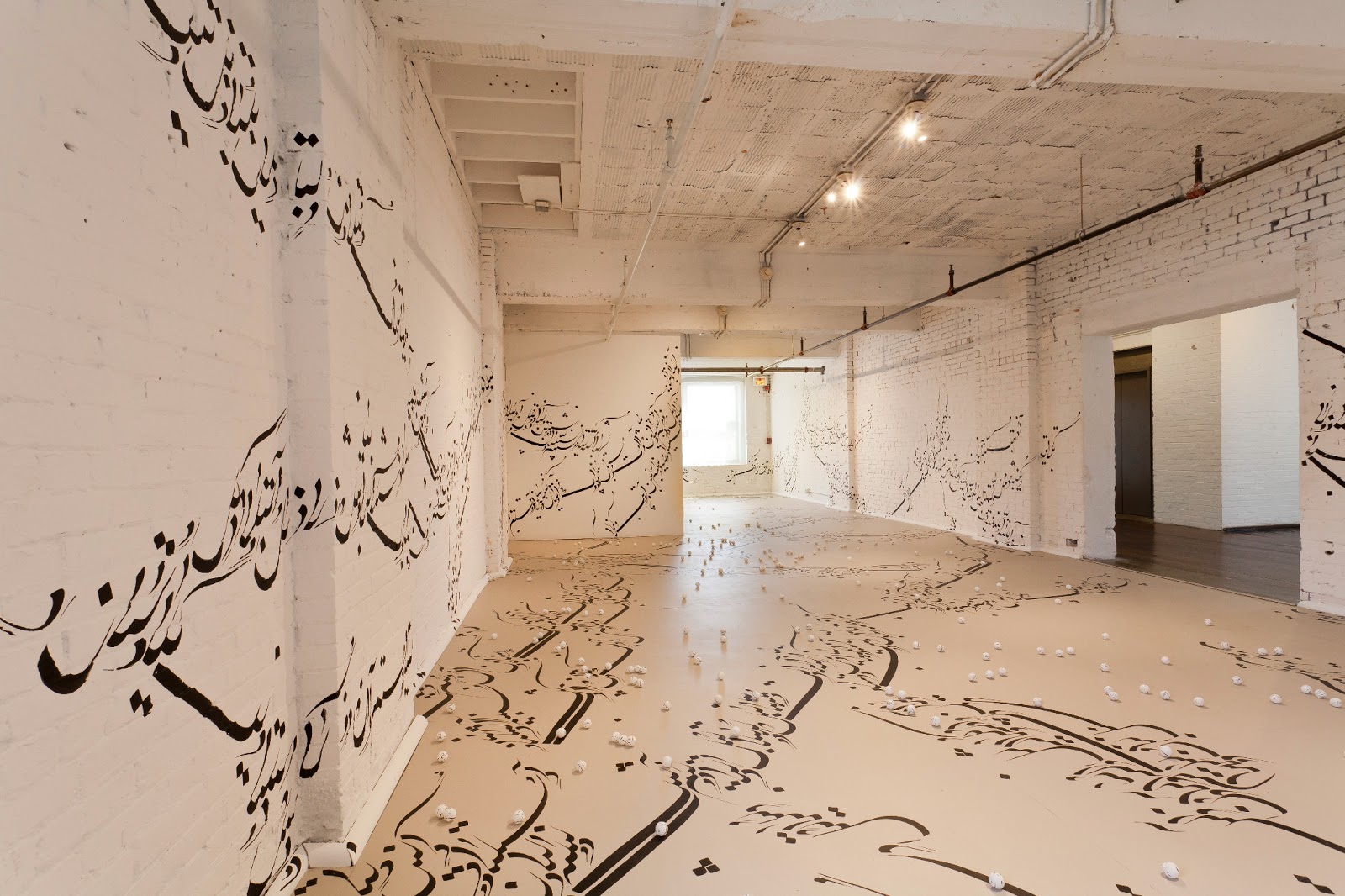Feminist
And…Orientalism:
The Work Of Parastou Forouhar
Through
her illustration, animation, painting, and sculpture, Forouhar observes how we,
as Westerners, observe “Oriental-Islamic” culture. To
the average Western viewer, the writing on the walls of Written Room is indecipherable. The Persian language becomes pure
ornamentation: a beautiful script that simultaneously alienates and contains
its audience. The cultural gulf created by the disparity between languages separates
the audience from what surrounds them. They can find no beginning, no end, and
no words for interpretation. The effect is that of expatriates in a foreign
country: thrust into a new culture and forced to give up an authoritative
standpoint, isolated by what surrounds them.
However,
Forouhar complicates her work. The Farsi on the walls only offers snippets of
phrases and words, leaving the piece broken and obfuscated to even those who
can read her writing. The choice to further the distance between the audience
and the artwork hints at the beginnings of the project as it relates to the
identity of an expatriate, distanced from both the culture she’s in and the
culture she’s from.
Forouhar’s
parents were assassinated on November 21, 1998. Her parents, Dariush
and Parvaneh Forouhar, were the first of the “Chain Murders”—political murders of
the Iranian government’s opposition. A year later, Forouhar began her Written Room project, building a body of
work that explores national identity from a country known for political
prosecution of women and activists.
Since
the deaths of her parents, the Iranian government has challenged Forouhar at
every attempt to memorialize her parents’ deaths. Most recently, in November of
2012, she was stopped and had her passport confiscated upon entering the
Iranian airport. Her precarious situation makes obvious the dilemma of the
expat existing between a cultures that misunderstands and a culture that
rejects.
You can view more of Forouhar’s work, as
well as read her essays on her website.
Feminist And…Community Perspectives:
Loraine Leeson’s Active Energy
“If there were any technology that could be developed that
you feel would best support yourselves or your communities, what would that
be?”
Loraine
Leeson's art practice revolves around the above question. Through her work,
she’s helped raise awareness for a variety of issues, bringing communities
together around a single cause. Her community-centered art has worked to
benefit communities for the past 30 years. In the 80s, Leeson co-founded the
Docklands Community Poster Project, which ran during the ten-year
re-development of the London Docklands. In 2002, she founded cSPACE, a website
dedicated to the exploration of collective creative practice.
In
2008, Leeson began Active Energy, a
series of interviews with the Geezers
Club in London’s East End. This project has Leeson directly asking her
subjects what technology they thought would support their community, and the
group banded together in answering the question with a concern about
alternative energy in the Thames. Since, the group has made a proposal to
install turbines in the river.
Find out more about Loraine Leeson’s work at the Active
Energy website and join in on the conversation in the comments below.
What technology do you feel would best help the local community?
Feminist And…Pepper’s Ghost:
Carrie Mae Weems’ Lincoln,
Lonnie, and Me
What do Carrie Mae Weems and Tupac Shakur have in common?
They’ve both taken the form of Pepper’s Ghost.
Carrie Mae Weems’ installation at Mattress Factory (which
recently traveled to the Look3 festival) builds on an already diverse body of
work that examines the legacies of racism, sexism, and classism in American
culture through far ranging media. For her piece at the Mattress Factory—Lincoln, Lonnie, and
Me – A Story in Five Parts—Weems skews the use of film in a way only she can,
by conjuring up Pepper’s Ghost., a technique with roots in the 16th-century
that still wows audiences today.
In the late 16th-century, Neapolitan scientist
Giambattista della Porta set down instructions for an illusion titled “How we
may see in a Chamber things that are not.” The instructions, which describe
using a polished glass pane to reflect objects completely outside the
audience’s field of vision, are (according to Wikipedia) the first description
of Pepper’s Ghost.
Since its popularization, the technique has been used by everyone including amateur haunted house builders to the team that brought Tupac Shakur back to life at Coachella 2012.
Weems uses the illusion to great effect, capitalizing on the
ethereal quality of Pepper’s Ghost to show how the history of race, gender, and
class in America still haunts our culture today.
-Posted by Matthew, marketing intern





No comments:
Post a Comment